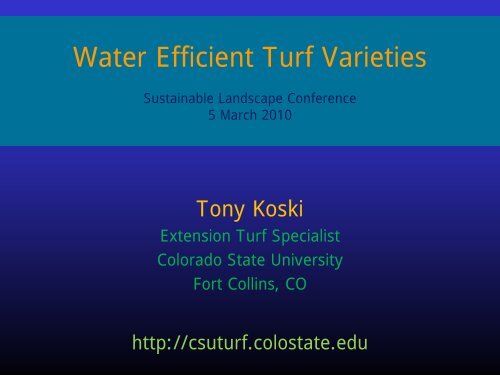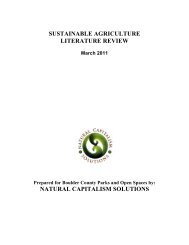Water Efficient Turf.. - Colorado State University Extension
Water Efficient Turf.. - Colorado State University Extension
Water Efficient Turf.. - Colorado State University Extension
Create successful ePaper yourself
Turn your PDF publications into a flip-book with our unique Google optimized e-Paper software.
<strong>Water</strong> <strong>Efficient</strong> <strong>Turf</strong> Varieties<br />
Sustainable Landscape Conference<br />
5 March 2010<br />
Tony Koski<br />
<strong>Extension</strong> <strong>Turf</strong> Specialist<br />
<strong>Colorado</strong> <strong>State</strong> <strong>University</strong><br />
Fort Collins, CO<br />
http://csuturf.colostate.edu
How are<br />
turf water use rate/ET<br />
turf drought resistance<br />
turf irrigation requirement<br />
related?
What is evapotranspiration (ET)?<br />
Evaporation is water<br />
that moves from the<br />
soil or plant surfaces<br />
into the atmosphere.<br />
Transpiration is water<br />
that moves from the<br />
soil, through the<br />
plant, and into the<br />
atmosphere.
<strong>Turf</strong>grass <strong>Water</strong> Use<br />
Total amount of water<br />
used for growth plus<br />
that lost by transpiration<br />
and evaporation from<br />
plant and soil surfaces.<br />
J. B. Beard, 1973
<strong>Turf</strong>grass Species ET* Rates<br />
Common Name Scientific Name ET *<br />
(mm day -1 )<br />
Tall Fescue Festuca arundinacea 7-13<br />
Perennial Ryegrass Lolium perenne 7-11<br />
St. Augustinegrass Stenotaphrum secundatum 6-11<br />
Seashore Paspalum Paspalum vaginatum 6-8<br />
Bahiagrass Paspalum notatum 6-8<br />
Kikuyugrass Pennisetum clandestinum 6-9<br />
Creeping Bentgrass Agrostis Palustris 6-10<br />
Centipedegrass Eremochloa ophiuroides 5-9<br />
Bermudagrass Cynodon spp. 4-9<br />
Zoysiagrass Zoysia spp. 5-8<br />
Kentucky Bluegrass Poa pratensis 4-7<br />
Buffalograss Buchloe dactyloides 3-6<br />
* ET rates when water is non-limiting; Potential Evapotranspiration<br />
Inches/wk<br />
2.0-3.8<br />
0.8-2.0
Drought Resistance in Plants<br />
Drought escape<br />
Drought avoidance<br />
Drought tolerance
Drought Escape<br />
Plant completes its life cycle<br />
prior to the onset of drought<br />
Example:<br />
Poa annua var. annua
Drought Avoidance<br />
Maintain growth when drought<br />
stressed<br />
Deep, extensive root systems<br />
High ratio of roots to shoots<br />
Xeromorphic characteristics (leaf<br />
rolling, hairy leaves, thick cuticle)<br />
May not possess good dormancy<br />
mechanism<br />
Recovery from extended, severe<br />
drought may be poor<br />
Examples:<br />
Tall fescue<br />
Perennial ryegrass<br />
St. Augustinegrass
Tall fescue (Festuca arundinacea)<br />
Slow thatch former<br />
“Tough” turf/good quality<br />
Few pest problems<br />
Low N requirement, and MAY<br />
reduce irrigation requirement<br />
Slow to recuperate from injury<br />
“Tender” when young<br />
May require more frequent<br />
mowing than KBG<br />
Tough leaves will dull mower<br />
blades more quickly
Drought Tolerance<br />
Plant parts (leaves, crowns,<br />
roots) can tolerate<br />
dehydration<br />
Often possess excellent<br />
dormancy mechanism<br />
Good ability to recover from<br />
dormancy<br />
Examples<br />
Kentucky bluegrass<br />
Buffalograss<br />
Bermudagrass<br />
Bromegrass<br />
Quackgrass
Kentucky bluegrass (Poa pratensis)<br />
High quality<br />
Great recuperator<br />
Sod-former<br />
Stress-resistant<br />
Thatch-former<br />
Poor shade tolerance<br />
Disease- and insectprone?<br />
Higher water and N<br />
requirements???
KBG Varieties for Drought Resistance<br />
SR2000<br />
Livingston<br />
America<br />
Unique<br />
Apollo<br />
Showcase<br />
Brilliant<br />
Classic<br />
Compact
<strong>Water</strong> Requirements of Annual<br />
Bedding Plants in CO<br />
19 annuals tested<br />
3 sites in CO<br />
Drip irrigation;<br />
mulched<br />
Irrigated using<br />
different<br />
percentages of<br />
bluegrass ET
Kentucky bluegrass<br />
(Poa pratensis L.)<br />
Kentucky bluegrass<br />
Texas bluegrass<br />
Hybrid bluegrass<br />
X<br />
Texas bluegrass<br />
(Poa arachnifera Torr.)
Research by Mary Suplick-Ploense (2000-2002)<br />
Rooting Patterns<br />
A-34<br />
KBG<br />
Reveille<br />
HBG<br />
Root Length Density at<br />
40-60 cm<br />
Field: HBG 6x KBG<br />
Greenhouse: HBG 12x KBG<br />
Total Root Length<br />
Field: HBG 2x KBG<br />
Greenhouse: HBG 2x KBG<br />
Total Root Mass<br />
Field: HBG 4x KBG<br />
Greenhouse: HBG 3x KBG
‘Bandera’ Texas X Kentucky Hybrid Bluegrass<br />
Seed Research of Oregon<br />
Bandera<br />
Improved seed<br />
germination<br />
High heat<br />
tolerance<br />
Active summer<br />
growth<br />
Stress tolerance<br />
Good turf quality
Hybrid Bluegrass Development<br />
Gardner <strong>Turf</strong>grass<br />
Reveille<br />
The Scotts Company<br />
Thermal Blue<br />
Solar Green<br />
Thermal Blue Blaze<br />
Dura Blue<br />
Seed Research of Oregon<br />
Bandera<br />
<strong>Turf</strong>-Seed Inc.<br />
Longhorn<br />
Rutgers <strong>University</strong><br />
Active breeding program
Buffalograss (Buchloe dactyloides)<br />
Native to North America<br />
Very stress resistant<br />
Lower (but NOT no!)<br />
maintenance<br />
Sod-former<br />
Can be difficult to grow from<br />
seed and plugs<br />
Poor traffic tolerance<br />
Dormant most of year<br />
Weeds will likely be a problem
Buffalograsses for <strong>Colorado</strong><br />
Seeded types<br />
Bowie, Cody, Bison, SharpShooter,<br />
Topgun, Plains, Sharps Improved,<br />
Texoka<br />
Vegetative types<br />
Legacy (excellent winterhardiness)<br />
Prestige (good winterhardiness)<br />
609 (marginal winterhardiness; use only<br />
in southeastern CO, or protected urban<br />
areas elsewhere in CO)
Prestige buffalograss lawn
Newer buffalograss cultivars<br />
have better traffic tolerance
Fine fescues (Festuca spp.)<br />
Plum Creek Golf Club<br />
fine fescue roughs<br />
Low maintenance<br />
Good stress tolerance<br />
Fine texture, high<br />
density<br />
Shade tolerant<br />
Poor traffic tolerance<br />
Can become thatchy<br />
Poor recuperation rate
The Fine Fescues<br />
Chewings Fescue<br />
Festuca rubra commutata<br />
Creeping Red Fescue<br />
Festuca rubra<br />
Hard Fescue<br />
Festuca ovina duriuscula<br />
Sheep's Fescue<br />
Festuca ovina tenuifolia<br />
Slender Creeping Red Fescue<br />
Festuca rubra trichophylla
Cold-Hardy Bermudagrass<br />
Seeded hybrids<br />
Good turf quality<br />
Heat and traffic<br />
tolerant<br />
Drought resistant<br />
Moderately quick<br />
establishment rate
Riviera bermudagrass<br />
Seeded 7 June 2008<br />
Picture taken 8 August
Annual Lawn Irrigation Requirements<br />
- <strong>Colorado</strong> Front Range -<br />
Supplemental irrigation requirements for the following lawn grass species assume:<br />
“Normal” precipitation (10-11 inches, April-October) and summer temperatures<br />
Good irrigation coverage (80% efficient irrigation system coverage)<br />
Extended drought and/or higher temperatures increase water needs for ALL grasses<br />
Kentucky bluegrass (KBG) will need 24-26 inches of supplemental irrigation per growing<br />
season to produce a lawn of good to excellent quality.<br />
Lower (but acceptable) quality KBG lawns can be grown with as little as 15-20 inches of<br />
irrigation (with normal precipitation and good irrigation coverage)<br />
Tall fescue may need 10% less irrigation than KBG (20-22 inches) IF it can grow deep<br />
roots and substantial subsoil moisture exists<br />
Tall fescue may require MORE irrigation than KBG if planted on poor/shallow soil, when<br />
subsoil moisture is deficient, or where deep rooting does not occur<br />
Fine fescue lawns will require 18-20 inches (but probably less…?)<br />
Buffalograss and blue grama lawns will require 8-10 inches (1-2 inches of irrigation per<br />
growing month) for a GOOD quality lawn that will tolerate moderate traffic/use<br />
Bermudagrass irrigation requirement is similar to that of buffalograss, or slightly less<br />
Kentucky bluegrass, fine fescue, buffalograss and bermudagrass can become dormant and<br />
survive prolonged periods (1-2 months) without precipitation and irrigation; tall fescue<br />
and perennial ryegrass lawns often die or become thin when deprived of water for similar<br />
time periods<br />
Dr. Tony Koski, <strong>Colorado</strong> <strong>State</strong> <strong>University</strong> Cooperative <strong>Extension</strong><br />
http://csuturf.colostate.edu Revised June 2006
Saltgrass (Distichlis spicata)<br />
• Native to the western U.S.<br />
• Excellent salinity tolerance<br />
• Excellent drought resistance<br />
• Heat and cold tolerant<br />
• Excellent traffic tolerance<br />
• Low fertility requirement<br />
Warm-season grass (long<br />
dormant period)<br />
Poor seed producer?<br />
Low germination rate?<br />
Slow to establish from plugs<br />
Can “penetrate” asphalt,<br />
cracks in concrete
Saltgrass Produces Deep Roots<br />
Excellent drought resistance and reduced irrigation requirement<br />
1 ft<br />
2 ft<br />
3 ft<br />
4 ft<br />
5 ft<br />
6 ft<br />
7 ft<br />
8 ft<br />
9 ft
















